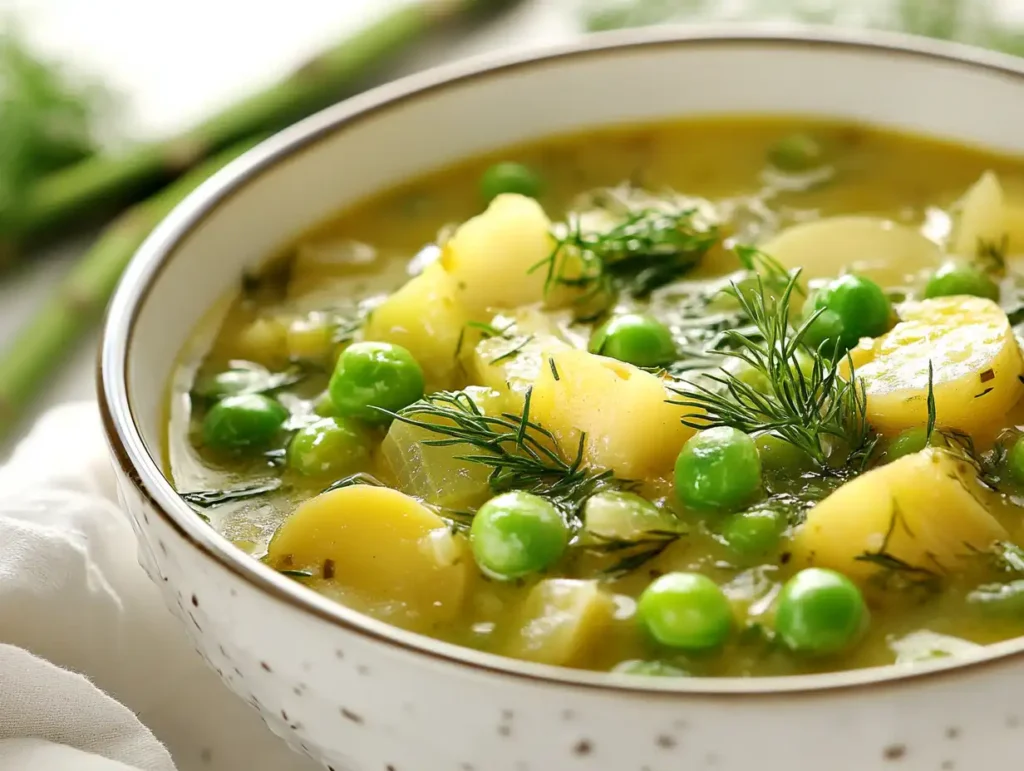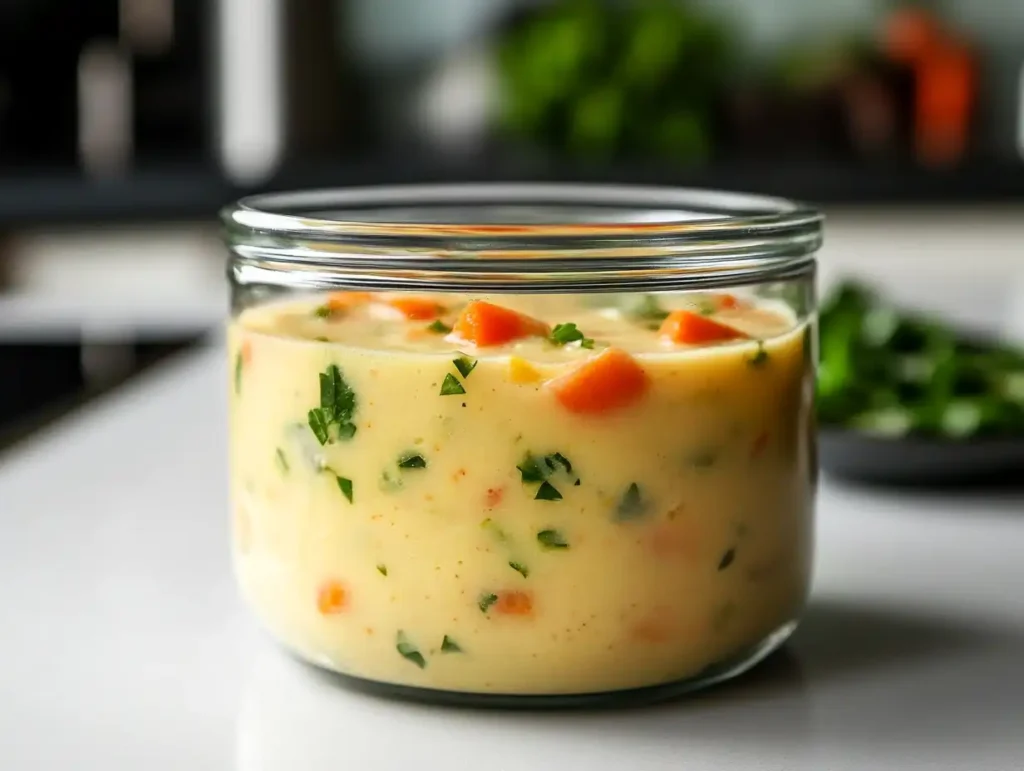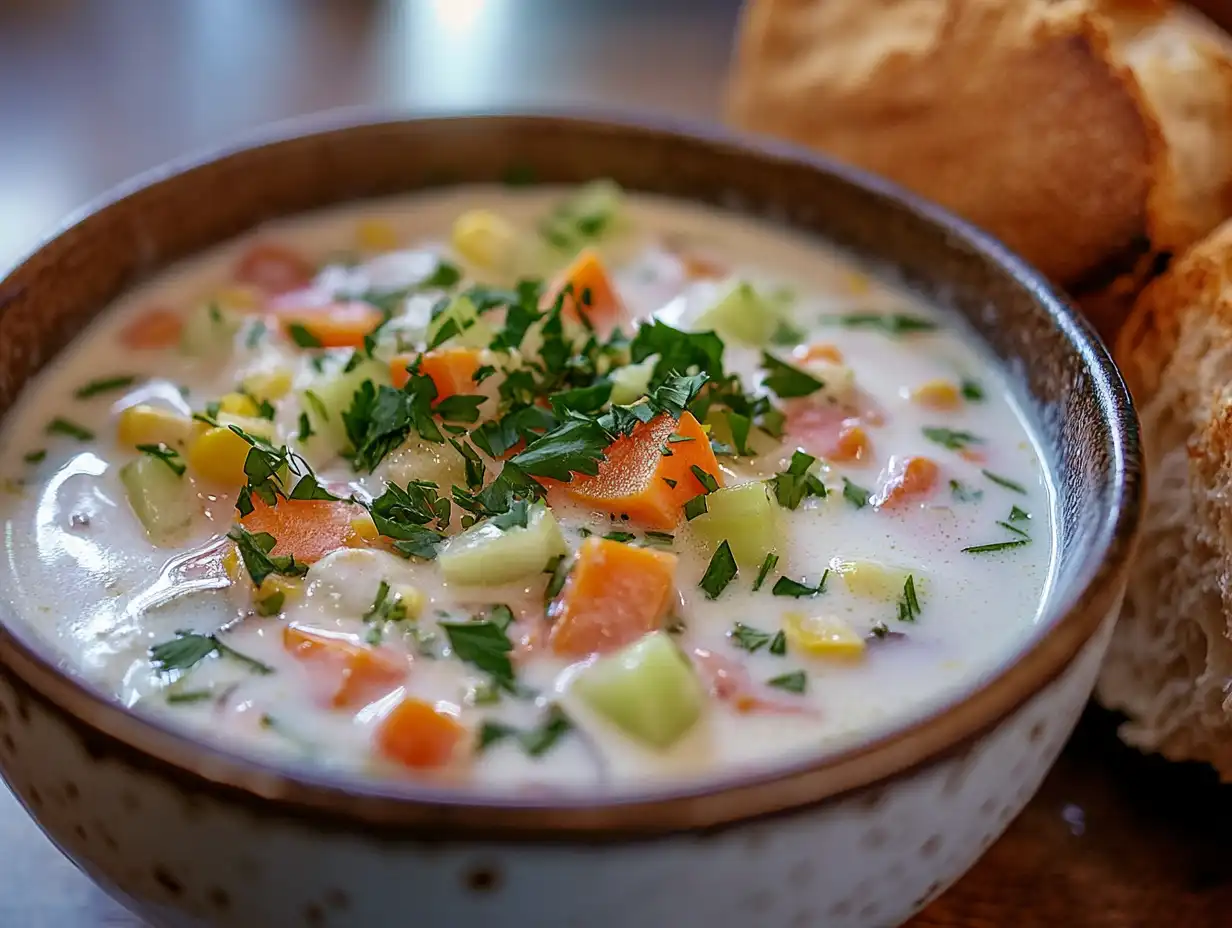Vegetable chowder is a comforting, flavorful dish that warms the soul and nourishes the body. Packed with a medley of vibrant vegetables, this creamy soup is a versatile meal that caters to various dietary preferences, from vegetarian to gluten-free options. Its hearty texture and robust flavors make it a popular choice for family dinners, festive occasions, or simply a cozy night in. Whether served as a standalone dish or paired with bread or salad, vegetable chowder offers the perfect blend of taste and nutrition.
The appeal of vegetable chowder lies not just in its rich taste but also in its adaptability. You can easily customize it with seasonal vegetables, local herbs, or a hint of your favorite spices. As a crowd-pleaser, it appeals to people of all ages, making it a staple in households worldwide. This article delves into the history, ingredients, preparation techniques, and benefits of vegetable chowder, offering a comprehensive guide to making this beloved dish.
The History of Chowder
Vegetable chowder is a modern adaptation of a dish with deep historical roots. Chowder, as we know it today, originated from coastal regions of Europe, particularly in France and England. The term “chowder” is believed to derive from the French word “chaudière,” which refers to the pot used for cooking stews. Early chowders were simple, hearty meals prepared by fishermen, combining their daily catch with available vegetables, water, and biscuits.
Over time, this culinary tradition crossed the Atlantic to North America, where it flourished in coastal communities. The addition of cream, milk, and other local ingredients gave rise to a variety of chowder styles, including New England clam chowder and corn chowder. Vegetable chowder emerged as a vegetarian-friendly alternative, gaining popularity for its robust flavors and health benefits.
Key Ingredients
The Vegetable Medley
At the heart of every vegetable chowder is an assortment of fresh vegetables. The most common choices include:
- Potatoes: Add creaminess and body to the soup.
- Carrots: Provide sweetness and color.
- Celery: Enhances the aroma and adds a mild crunch.
- Corn: Offers a natural sweetness and a burst of texture.
- Bell Peppers: Introduce a subtle zing and vibrant hues.
Broth and Dairy Components
Vegetable chowder typically combines a rich vegetable broth with milk or cream. These ingredients lend a creamy texture and blend the flavors of the vegetables seamlessly. For vegan versions, coconut milk or cashew cream are excellent substitutes.
Herbs and Spices
Seasoning is vital to the flavor profile of vegetable chowder. Common herbs and spices include:
- Thyme and Parsley: For a fresh, earthy flavor.
- Bay Leaves: To enhance the depth of the broth.
- Paprika: Adds warmth and a smoky undertone.
- Salt and Pepper: The classic pair for seasoning to taste.
Optional Additions
Vegetable chowder is highly versatile. You can enhance its nutritional value and flavor by adding:
- Beans or Lentils: For extra protein.
- Cheese: Such as cheddar or parmesan for a richer taste.
- Mushrooms: To introduce a meaty texture and umami notes.
This wide array of ingredients ensures that every bowl of vegetable chowder is a wholesome, satisfying experience.
The Cooking Process
Making vegetable chowder is straightforward, yet it requires some careful attention to ensure the best results. First of all, start by preparing your ingredients. Then, proceed to chop all the vegetables into uniform pieces, as this ensures even cooking. Once the preparation is done, it’s time to cook.
To begin with, sauté the aromatics, like onions and garlic, in a large pot until fragrant. Next, add the harder vegetables, such as carrots and potatoes, giving them a quick stir. Afterward, pour in the broth and seasonings, allowing the mixture to simmer. Meanwhile, you can prepare any garnishes or sides that will accompany the chowder. By the time the vegetables are tender, you will have a flavorful base ready to be finished with cream or a plant-based alternative.
Health Benefits
Vegetable chowder is as nutritious as it is comforting, offering a wealth of health benefits:
Rich in Vitamins and Minerals
- Potatoes are a great source of potassium and vitamin C.
- Carrots provide beta-carotene, which supports eye health.
- Celery contributes antioxidants and dietary fiber.
- Corn offers B vitamins and essential minerals like magnesium.
Low in Calories, High in Nutrients
Vegetable chowder is naturally low in calories, especially when prepared with plant-based milk. It provides a balanced mix of macronutrients and micronutrients, making it suitable for weight management.
Supports Heart Health
The use of vegetables, particularly those rich in fiber and antioxidants, helps reduce cholesterol levels and supports cardiovascular health. Replacing heavy cream with lighter options or non-dairy substitutes further enhances its heart-healthy appeal.
Boosts Immunity
The vitamins, minerals, and antioxidants in vegetable chowder strengthen the immune system. Garlic and onions, often used as a base, have natural antimicrobial properties that promote overall health.
With its combination of flavor, nutrition, and ease of preparation, vegetable chowder proves to be a versatile addition to any meal plan.
Vegetable Variations
One of the most appealing aspects of vegetable chowder is its adaptability. Whether you want to experiment with seasonal produce or cater to dietary preferences, you can create countless variations of this hearty soup.
Seasonal Twists

- Spring: Incorporate asparagus, peas, and fresh herbs like dill or tarragon for a light, vibrant chowder.
- Summer: Take advantage of summer squash, bell peppers, and sweet corn to create a bright and flavorful version.
- Fall: Add butternut squash, parsnips, and leeks for a warm, earthy flavor profile.
- Winter: Use root vegetables like turnips, rutabagas, and kale for a comforting, nutrient-dense bowl.
Regional Inspirations
- Mediterranean-Style: Add sun-dried tomatoes, zucchini, and fresh basil, along with a drizzle of olive oil for garnish.
- Spicy Mexican Twist: Include black beans, diced tomatoes, jalapeños, and a sprinkle of chili powder or cumin. Top with fresh cilantro and lime.
- Asian-Inspired: Use coconut milk as the base and add bok choy, ginger, and a touch of soy sauce or miso paste.
Protein Boosts
For a more filling chowder, consider adding plant-based proteins such as chickpeas, lentils, or tofu. If you eat animal products, shredded chicken or crumbled bacon can enhance the dish.
Diet-Specific Adjustments
- Gluten-Free: Use cornstarch or arrowroot powder to thicken the soup instead of flour.
- Vegan: Replace cream with cashew cream or coconut milk, and butter with plant-based alternatives.
- Low-Carb: Substitute potatoes with cauliflower for a lower-carb version without sacrificing creaminess.
Perfect Pairings
In addition to being a standalone dish, vegetable chowder pairs beautifully with sides and beverages. For example, crusty artisan bread complements the creamy texture of the chowder perfectly. Furthermore, a simple Caesar salad adds a refreshing crunch that balances the richness of the soup. As for beverages, white wine or herbal tea enhances the meal without overpowering the flavors.
On the other hand, if you prefer something heartier, garlic breadsticks or roasted vegetables can make the meal more substantial. Consequently, these pairings turn your vegetable chowder into a well-rounded dining experience, perfect for any occasion.
Serving and Presentation
The way you serve and present vegetable chowder can elevate its appeal, making it as pleasing to the eyes as it is to the palate.
Plating and Bowls
- Rustic Style: Serve the chowder in bread bowls for an impressive, edible presentation.
- Modern Touch: Use wide, shallow bowls to showcase the vibrant colors of the vegetables.
- Casual Approach: Large, cozy mugs are perfect for serving chowder on casual evenings.
Garnishing Ideas
- Herbs: Sprinkle fresh parsley, thyme, or chives over the top for a pop of color and freshness.
- Cheese: Grate a little parmesan or sharp cheddar for a creamy, savory topping.
- Crunchy Add-Ons: Croutons, toasted nuts, or crispy fried onions add delightful texture.
- Drizzle: Finish with a swirl of olive oil or cream for a polished look.
Accompaniments
- Offer sides like warm cornbread, roasted vegetables, or a tangy coleslaw to round out the meal.
Common Mistakes to Avoid
Even seasoned cooks can stumble on small mistakes when making vegetable chowder. Here’s how to steer clear of common pitfalls:
Overcooking Vegetables
- Simmer the chowder only until the vegetables are tender to avoid a mushy texture.
Using Too Much Liquid
- Balance the liquid-to-vegetable ratio to maintain the thick, creamy consistency that defines chowder.
Skipping the Seasoning
- Chowder relies heavily on well-layered flavors. Always taste and adjust salt, pepper, and herbs during cooking.
Not Thickening Properly
- If the chowder is too watery, use mashed potatoes, cornstarch slurry, or a blended portion of the soup to thicken it naturally.
Serving Immediately
- Allow the chowder to rest for 5–10 minutes after cooking. This helps the flavors meld together, creating a richer taste.
Cooking Tips for Beginners
For those new to making chowder, these tips will ensure success:
Prep in Advance
- Chop all your vegetables, measure the broth, and gather seasonings before starting to cook. This minimizes stress during the cooking process.
Low and Slow Cooking
- Simmer the chowder over medium to low heat to avoid scorching the milk or cream.
Invest in Tools
- A heavy-bottomed pot prevents burning, while an immersion blender allows you to control the texture.
Experiment Freely
- Don’t hesitate to swap vegetables or spices to suit your taste or use what’s in season.
Start Small
- If unsure, make a smaller batch first to experiment with flavors and techniques without waste.
By avoiding common mistakes and following beginner-friendly tips, anyone can create a delicious and satisfying vegetable chowder that feels like it came from a professional kitchen.
Storage and Reheating

Properly storing and reheating your vegetable chowder ensures you can enjoy leftovers without compromising taste or texture.
How to Store Chowder
- Refrigeration: Transfer the chowder to an airtight container once it has cooled to room temperature. It can be refrigerated for up to 3–4 days.
- Freezing: Vegetable chowder freezes well, but avoid adding dairy before freezing as it can separate when reheated. Freeze in portion-sized containers for convenience.
Reheating Tips
- Stovetop: Reheat gently over medium-low heat, stirring frequently to prevent scorching. If the chowder thickened in storage, add a splash of milk or broth to restore the desired consistency.
- Microwave: Heat in short intervals, stirring between each, to ensure even heating.
Enhancing Flavor
- Add fresh herbs or a sprinkle of cheese during reheating to restore vibrancy.
FAQs About Vegetable Chowder
1. Can I make vegetable chowder vegan?
Yes, absolutely! Substitute dairy milk with plant-based alternatives like almond milk, coconut milk, or cashew cream. Use vegan butter or olive oil for sautéing.
2. How do I prevent my chowder from being too watery?
To thicken your chowder, you can use blended potatoes, a flour or cornstarch slurry, or an immersion blender to partially puree the soup.
3. Can I use frozen vegetables?
Yes, frozen vegetables work well in chowder. Add them during the last few minutes of cooking to avoid overcooking.
4. What is the best way to add spices to my chowder?
Add spices early during the sautéing stage to bloom their flavors, then adjust seasoning towards the end of cooking to taste.
5. How can I make chowder gluten-free?
Replace flour with gluten-free alternatives like cornstarch, potato starch, or arrowroot powder for thickening. Ensure any store-bought broth or seasonings are gluten-free.
6. What’s the best way to customize chowder for picky eaters?
Blend the soup to create a smooth texture, which can make it more appealing to picky eaters. Incorporate mild-tasting vegetables like zucchini or squash and adjust seasonings for a gentler flavor.
Conclusion
Vegetable chowder is a timeless dish that offers comfort, nutrition, and endless customization possibilities. From its humble origins to its status as a modern culinary favorite, chowder has evolved to suit every taste and dietary need. Whether you’re making a traditional version or experimenting with global flavors, this hearty soup is sure to delight family and friends alike.
With simple ingredients, easy preparation steps, and a myriad of ways to personalize it, vegetable chowder is a dish that belongs in every home cook’s repertoire. Serve it warm on a cold evening, pair it with crusty bread, and enjoy the rich, creamy goodness that defines this classic meal.
Explore other delicious recipes like Healthy Black Bean Noodles for a nutritious twist, or enhance your meal with the perfect Sourdough Garlic Bread. If you love classic desserts, don’t miss our delightful French Apple Pie recipe!

